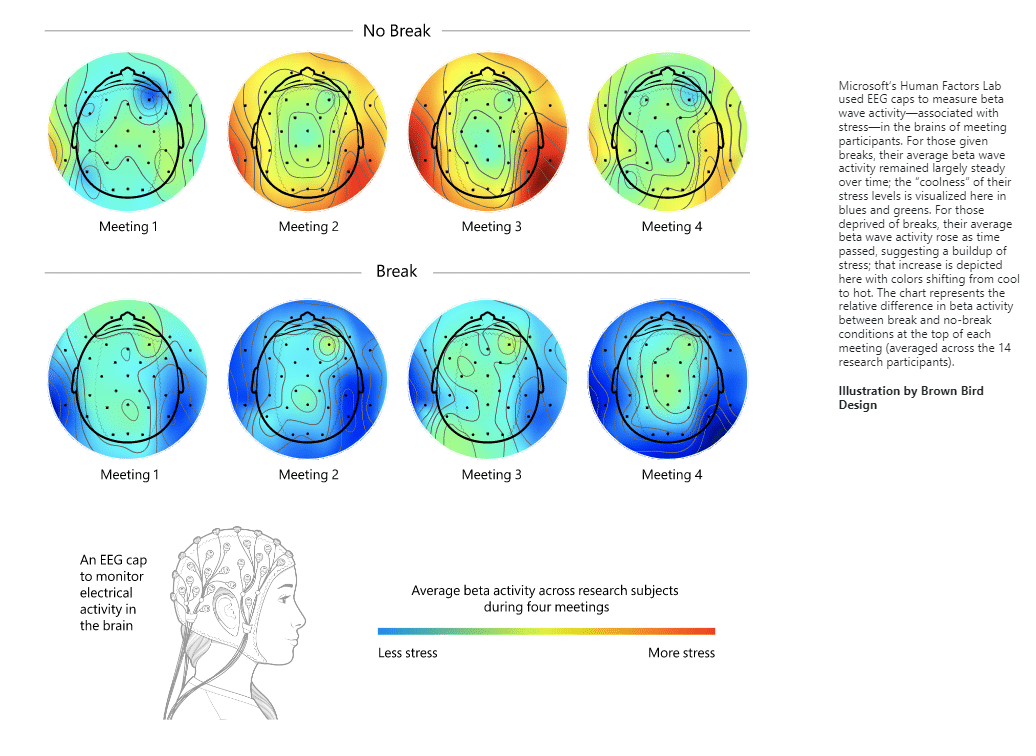How many meetings do you attend per week? For how long? Do you have any break in between? Stay with me and after this post you will more convinced why this will make a difference in your life and career and how to improve this now.
For many people, back-to-back video meetings are a common occurrence, leaving little time for breaks in between. But this constant mental strain can lead to a state of mental exhaustion known as meeting fatigue. In a recent study conducted by Microsoft’s Human Factors Lab, researchers confirmed that taking short breaks can help to combat this fatigue and improve our ability to focus and engage during meetings.
In the study, 14 volunteers participated in two different sessions of back-to-back video meetings while wearing EEG equipment to monitor their brain activity. In one session, the participants took 10-minute breaks between each half-hour meeting to meditate using the Headspace app. In the other session, the participants had no breaks.
The results showed three key findings:
Breaks between meetings allow the brain to “reset,” reducing the cumulative build-up of stress that occurs during back-to-back meetings.
Back-to-back meetings can decrease your ability to focus and engage. When participants had meditation breaks, their brainwave patterns showed higher levels of frontal alpha asymmetry, indicating higher engagement during the meeting. Without breaks, these levels were negative, suggesting a lack of engagement.
Transitioning between meetings can be a source of high stress, as the brain has to switch gears and focus on something else. Taking a short break during this transition can help to alleviate this stress and improve our ability to focus on the next task.
Therefore, my friend, taking breaks during long meetings is important for reducing stress and improving focus and engagement. It’s not just about self-care, but also about operationalizing much-needed breaks into daily routines to ensure that we can do our best work. By incorporating short breaks into your meeting schedule, you can give your brain the rest it needs to stay sharp and focused.
There are several other strategies you can use to keep your brain functioning at its best during long meetings.
- Stay hydrated: Drinking water helps to keep your brain hydrated, which is essential for proper brain function. Make sure to bring a bottle of water to your meetings and take sips throughout to keep your brain fuelled.
- Eat healthy snacks: Snacking on healthy foods, like nuts or fruit, can help to keep your energy levels up and your brain functioning at its best. Avoid sugary or high-fat snacks, as these can lead to an energy crash later on.
- Use visualization techniques: Visualization techniques, like mind maps or diagrams, can help to organize your thoughts and keep your brain engaged. These techniques can also help to break up the monotony of a long meeting and give your brain a fresh perspective.
- Take notes: Taking notes during a meeting not only helps you to remember important information, but it also keeps your brain active and engaged. Write down key points and questions, and review your notes after the meeting to reinforce your understanding
The length and frequency of your meeting need to change too. Set priorities and once you do accept or organize a meeting, make sure you:
- Set a clear agenda and stick to it: Clearly outlining the purpose and goals of the meeting can help to keep the conversation on track and ensure that it stays focused and efficient.
- Invite only necessary attendees: Inviting too many people to a meeting can lead to unnecessary distractions and side conversations. Only invite those who are necessary for the decision-making process or who can provide valuable input.
- Consider alternative communication methods: Sometimes, a quick phone call or email can be more effective than a full meeting. Consider using alternative methods of communication for tasks that don’t require in-person discussion.
- Use a timer: Setting a time limit for the meeting can help to keep it focused and on track. Consider using a timer to ensure that the meeting stays within the allotted time frame.
- Encourage breaks: Taking short breaks during long meetings can help to alleviate stress and improve focus and engagement. Encourage your team to take breaks during extended meetings to help keep their brains sharp and focused.
- Consider organizing walking meetings. A walking meeting is a meeting that takes place while walking, rather than sitting in a conference room or at a desk. Walking meetings can be a great alternative to traditional meetings, as the physical activity can help to stimulate the brain and improve creativity and problem-solving abilities. Walking meetings can also be a good way to get some fresh air and break up the monotony of sitting in a conference room all day. They can be held outdoors, on a walking trail, or even just around the office building. Walking meetings can be an effective way to have focused, productive conversations while getting some exercise at the same time.
Tags productivity, brain, long meeting, Microsoft, brain scan, efficiency


